This post is the second in a series of behind-the-scenes peeks at the creation of the art of
The Last Extinction, taken from Steve Buccellato's
other blog.
Click here to read part one.
The video above is just one shot in what was probably the most complicated sequence we created for the
promotional trailer for
TLE. The scene depicts a Chinese shark-finning boat, floating derelict in the ocean. As the camera gets closer (following a swarming flock of gulls and other sea birds), we witness unspeakable carnage on the ship. From the stern, we see hooks and lines trailing down into the ocean depths, where the camera follows, revealing another kind of horror beneath the waves.
Really, the final underwater shot was so massive and complicated that it deserves a blog post of its own, which will follow at some point. Today, I'm going to focus on the fairly simple shot above, following the many steps from start to finish... But first, here is the entire sequence as I originally storyboarded it...
These boards were created after much discussion with
TLE Writer/Producer
Michael Hanrahan and his lead animator (at the time),
Scott Walker, of
Highliner Studios. We decided to create these images as 2D digital paintings in Adobe Photoshop, designed for animating in After Effects, using multiple layers to separate objects and planes.
Layers were key to our success. One important benefit of creating our scenes from scratch, rather than using stock photos or more traditional 2D images, was that we could customize each piece of art with animation in mind. Therefore, any environment had multiple layers from foreground to background, with
complete art behind each layer above. As well, characters, props and anything in the extreme foreground needed to exist as separate, fully-realized pieces of art.
 |
| an example of the storyboard, along with initial notes to indicate the important layers necessary to animation |
|
On this particular scene, I hired the amazingly talented
John Van Fleet to paint all the elements. John is one of two artists assembled for
TLE that I've worked with in the past. He's an extremely versatile artist, who I first got to know when he was painting graphic novels for
Marvel Comics.
 |
| Typhoid by Ann Nocenti & John Van Fleet |
John's work on
TLE has been exceptional, and his attention to technical detail has, in many ways, set the bar high for much of the project.
Getting back to process, however... The first step with this scene (and all others) was to provide John with detailed boards (like the one above), as well as technical specs, notes and photo reference to help inspire and inform the shot. In turn, John would send me increasingly detailed artwork, as we provided feedback at each step. Here are a few iterations of this first shot...
 |
| early version: art by John Van Fleet |
 |
| early version: art by John Van Fleet |
 |
| final version: art by John Van Fleet |
You can see many apparent differences here, including the color and texture of the ocean, the design and details of the boat and the 'wake' behind it. Changes were made for different reasons; some purely aesthetic, others to match the scene as it reads in the book, or to heighten the reality.
When it came to the ship itself, John took it upon himself to model it in a 3D program first, and paint over it. This allowed him to keep its details consistent throughout the scene.
 |
| model by John Van Fleet |
This particular shot was fairly straightforward. Once we had the main details down, and the shot captured the mood we were going for, it was smooth sailing, so to speak. Some other shots from the scene required much more back-and-forth to get all the elements in line.
Below is a typical example of how I'd direct the work of John and the other artists, usually accompanied by extensive emailed notes and more examples of photo reference. Many of the artists on
TLE lived in other parts of the world, and so email was our main form of communication (we had artists in Sweden, Russia, France and around the U.S.).
The example above was from a complicated shot that John completed, but was not used. It was supposed to provide a transition between the shot showing the deck of the ship, and the underwater tracking shot. The use of 'swarming' birds would have been crucial to selling these shots, and creating a feeling of total chaos. In the editing, we realized it wasn't necessary. In the end, not every shot that I storyboarded was painted, and not every frame painted appeared in the promotional trailer.
 |
| art by John Van Fleet |
 |
| art by John Van Fleet |
Once these layered Photoshop files were complete, the files were passed on to the animators who brought the images to life in Adobe After Effects. In many cases, new elements were added at this stage, including certain lighting and atmospheric effects, some sound effects, and simulated camera tricks such as blurred focus and camera movements. In the case of this shot, the animators had to multiply the birds and have them 'swarm' convincingly, as well as creating realistic movements in the water and fog.
The end result is the video clip at the top of this blog post. When each shot was completed in this way, the Video Editor, Damon Caussen, had the raw materials to put together the finished trailer (along with other assets, such as the musical score, voice-overs and some stock video footage). All throughout, Michael and I had access to the work in-progress, providing input.
Most of the scenes followed this basic procedure to produce. However, several scenes or individual shots required special techniques to get the required results. Next time, I'll tell you about one of those exceptions...
































